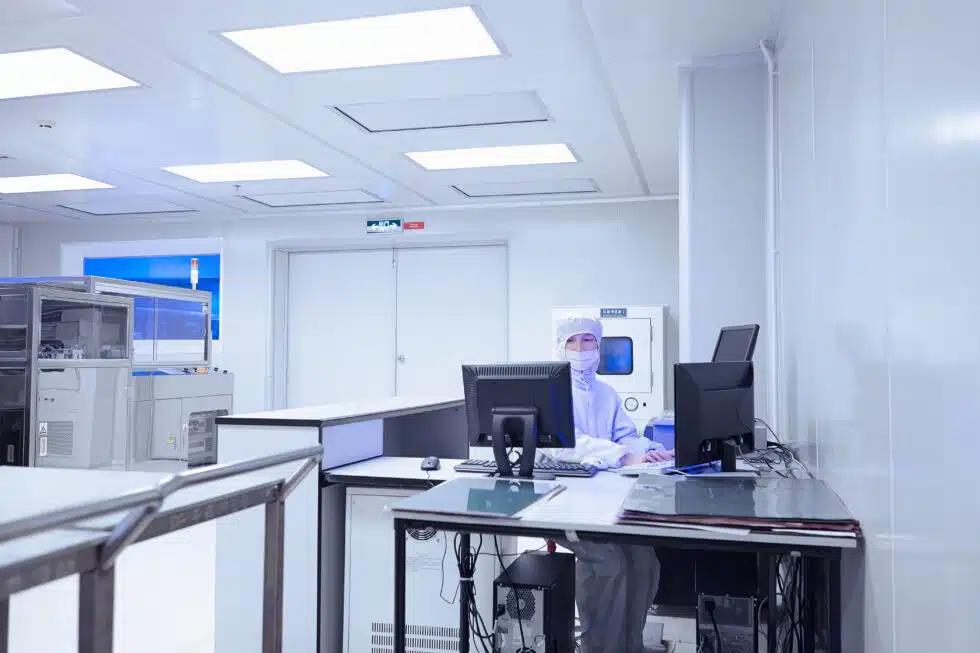Whilst some parameters of a cleanroom are dependent on the level and type of contamination risk, what they all have in common is a need to control the concentration and maximum size of dust particles to a specified level.
This means that the ideal cleanroom surface material should be:
- Smooth; textured surfaces are more difficult to clean and are more likely to generate dust particles when other material rubs against them.
- Non-slip and firm; both for operator safety and avoidance of product damage. The hardness of Rhino’s surface protection mats offers a good balance of protective flexibility for cushioning and grip, whilst providing stability and support.
- Non-scratch: scratches on a cleanroom surface are an ideal harbour for trapped fibres and other contaminants. A self-healing cutting mat is ideal for where knives or other sharps are used, both protecting the blade’s sharpness and the bench.
- Easy to remove; surfaces that are fixed to the bench often have hard-to-clean gaps, and if they do get damaged or worn are expensive to replace. Rhino’s mats are robust enough to stay put but are quick to remove for clean-down. They also allow mats to be kept for each particular material worked, further avoiding cross-contamination.
- Inert and nonreactive: Depending on any solvents, material or chemicals being used (including cleaning products), care should be taken to avoid reactions occurring between surface and product. Speak to the manufacturers about this or conduct your own test if the data is not available. Rhino offers free samples of their cleanroom surface for you to try.
The avoidance of “generation and retention of particles” is down to the room’s internal surfaces; walls, floors and ceilings, but most importantly the workbench surface. This is where the risk of dust creation arises from surfaces rubbing together, and operators moving about in close proximity. Of course, it is also where some of the most critical processes take place in the product’s manufacture.
In terms of cleanroom construction detail, there isn’t a one-size-for-all product as every cleanroom situation has its own level of control needed in addition to any process needs such as temperature and humidity control.
Cleanrooms are to be found in many very different industries, either for testing laboratory purposes or advanced manufacturing; Aseptic procedure is usually the key factor in Life Sciences such as medical device manufacture, biotechnology and pharmaceutical. In medically sterile environments, dust particles are known as non-viable particles, in that they don’t propagate but are nevertheless a serious contaminant.
Cleanrooms for semiconductor chip production, advanced materials, and the assembly of precision optics will likely have physical dust contamination as the number one priority.
ISO 14611-1 defines such a room as a “Room in which the concentration of airborne particles is controlled, and which is constructed and used in a manner to minimize the introduction, generation, and retention of particles inside the room, and in which other relevant parameters, e.g. temperature, humidity and pressure are controlled as necessary”
The introduction of air-borne contamination can largely be controlled by air-flow management (filters, door seals, positive pressure internally etc). If the category demands it, further access control and procedures such as air-showers and donning special gowns are employed.
Particulate matter in cleanroom air is measured in the number of particles of 0.5 microns and larger contained within 1 cubic metre of air, with a ten-fold change in acceptable contamination with each category step change. Surface contamination is most commonly monitored by swab tests.
There are nine levels of controlled environment specified in ISO 14644; the international standard for cleanrooms. Some critical manufacturing facilities involve a series of interconnected cleanrooms that have different levels of contamination & control strategy (CCS), engineering controls and cleanliness specification. This is because cleanroom design, installing, maintaining and operating costs get exponentially greater as the category level increases. An example of a multi-clean room facility in a pharmaceutical manufacturing line might consist of:
|
PROCESSES |
ISO CLEANROOM LEVEL |
| Ante-area; personal hygiene and garbing, unboxing and staging of components |
8 |
| Buffer area; air filter equipment, final preparations of raw material |
7 |
| Inner Packaging Preparation |
6 |
| Compounding and sealing |
5 |
| Boxing sealed material into final packaging |
7 |


